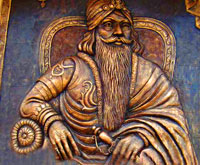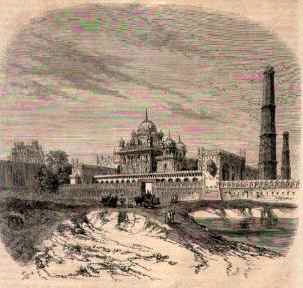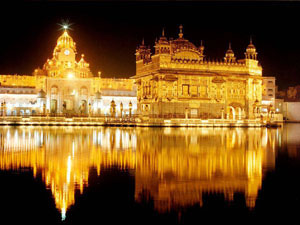Gurdwaras built by Maharaja Ranjit Singh
At the Golden temple much of the present decorative gilding and marblework date from the early 1800s. All the gold and exquisite marble work were conducted under the patronage of Emperor Ranjit Singh, Maharaja of the Sikh Punjab. The ''Sher-e-Punjab'' Empire of the (Lion of the Punjab), was a heavy donor of wealth and materials for the shrine and is remembered with much affection by the Punjabi people. Maharaja Ranjit Singh also built two of the other most sacred temples in Sikhism. This was due to Maharaja Ranjit Singh having a deep love for the tenth Guru of Sikhism Guru Gobind Singh. The other two most sacred temples in Sikhism, which he built, are Takht Sri Patna Sahib (intiation or birth place of Guru Gobind Singh) and Takht Sri Hazur Sahib the place of Guru Gobind Singh's Sikh ascension into heaven.

Just like Maharaja Ranjit Singh has donated to have the Harmandir Sahib in Amritsar covered with gold leaf, he donated gold so that the roofs of Vishvanath temple in Banaras and Jwalamukhi and Kangra temples can be covered with gold leaf. He had willed that the Kohinoor diamond be donated to the Jagannath Temple in Puri.
At the Harmandir Sahib, much of the present decorative gilding and marblework date back from the early 19th century. The gold and intricate marble work were conducted under the patronage of Maharaja Ranjit Singh, Maharaja of the Punjab. The Sher-e-Punjab (Lion of the Punjab) was a generous patron of the shrine and is remembered with much affection by the Sikhs. Maharaja Ranjit Singh deeply loved and admired the teachings of the Tenth Guru of Sikhism Guru Gobind Singh, thus he promoted the teachings of the Dasam Granth (the Tenth Granth) and built two of the most sacred temples in Sikhism. These are Takht Sri Patna Sahib, the birth place of Guru Gobind Singh, and Takht Sri Hazur Sahib, the place where Guru Gobind Singh took his final rest or mahasamadhi, in Nanded, Maharashtra in 1708.

Samadh of Maharaja Ranjit Singh:
(1780-1839) Lahore : This mausoleum of the powerful ruler of the Sikh dynasty is situated just opposite the Lahore Fort. His Samadh occupies the spot where he was cremated. The architecture is mixture of Mughal and Hindu styles. This building was built in 1848 A.D by Kharak Singh son of Ranjit Singh. The square roof with a central fluted dome is crowded around with Naga hood designs. The interior of the chamber is elaborately decorated with fresco pertaining to Sikh gurus etc. In the center of the sepulchral chamber is a small four column domed marble pavilion beautifully decorated with pietra aura work. In this pavilion is a marble urn in the form of lotus containing ashes of the Maharaja. Eleven smaller knobs hold ashes of four queen and seven slave girls. Kharak Singh, the successor of Ranjit Singh, died in 1840 and their ashes rest side by side with his son Naunihal Singh in the domes of Ranjit Singh's mausoleum.


At the Harmandir Sahib, much of the present decorative gilding and marblework date back from the early 19th century. The gold and intricate marble work were conducted under the patronage of Maharaja Ranjit Singh, Maharaja of the Punjab. The Sher-e-Punjab (Lion of the Punjab) was a generous patron of the shrine and is remembered with much affection by the Sikhs. Maharaja Ranjit Singh deeply loved and admired the teachings of the Tenth Guru of Sikhism Guru Gobind Singh, thus he promoted the teachings of the Dasam Granth (the Tenth Granth) and built two of the most sacred temples in Sikhism. These are Takht Sri Patna Sahib, the birth place of Guru Gobind Singh, and Takht Sri Hazur Sahib, the place where Guru Gobind Singh took his final rest or mahasamadhi, in Nanded, Maharashtra in 1708.
Revered as "Sachkhand Sri Hazur Abchal Nagar Sahib", this historical shrine, which is one of the five Takhts (thrones) of the Sikhs is situated near Godavari river and was constructed by Maharaja Ranjit Singh ji at the site where Guru Gobind Singh ji breathed his last. It took 5 years to complete (1832-1837).
When Shere-E-Punjab Maharaja Ranjit Singh learnt that there is no big memorial at Nanded where Sarbans Dani, the Tenth Master Shri Guru Gobind Singh Ji had spent his last days, he deputed Chanda Singh to build a Grand Gurudwara. The Construction of Gurudwara Sachkhand Sri Hazur Sahib was undertaken at Nanded at this place from where Shri Guru Gobind Singh Ji had left for heavenly abode in 1708 A.D.
During the construction, acute shortag of water was felt. Meit Jathedar Baba Gahoo Singh Ji built this Holy Well through Kaar Seva some in around 1838 A.D. to meet the requirement. Traditionally every day one Gagar (Pitcher) is filled from river Godavari and another drawn from this holy well for giving bath to the Singhasan Sahib of Shri Guru Gobind Singh Ji in Sachkhand Shri Hazur Sahib.


